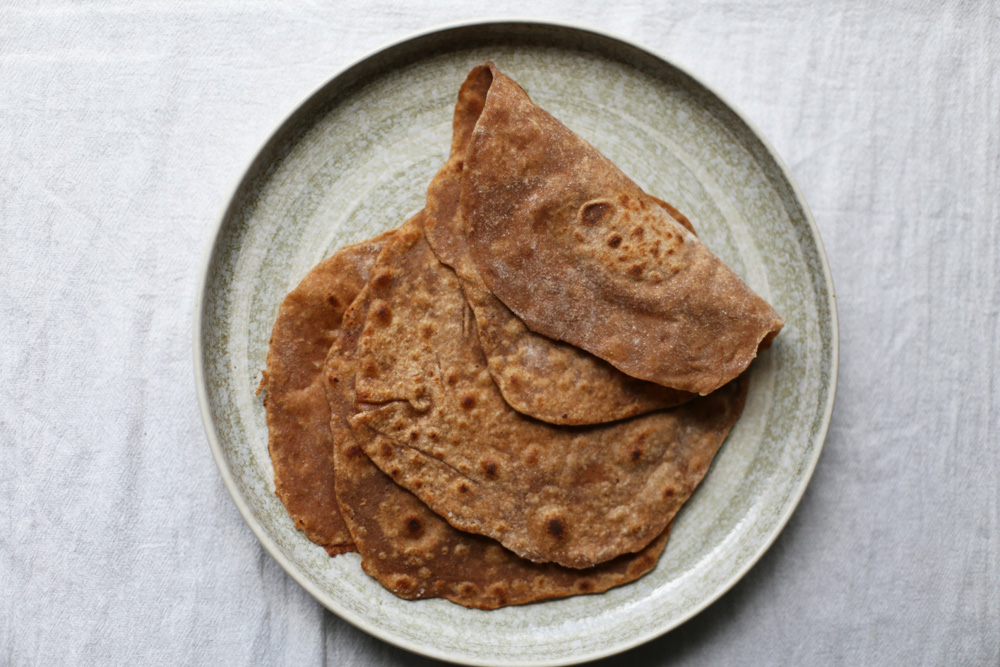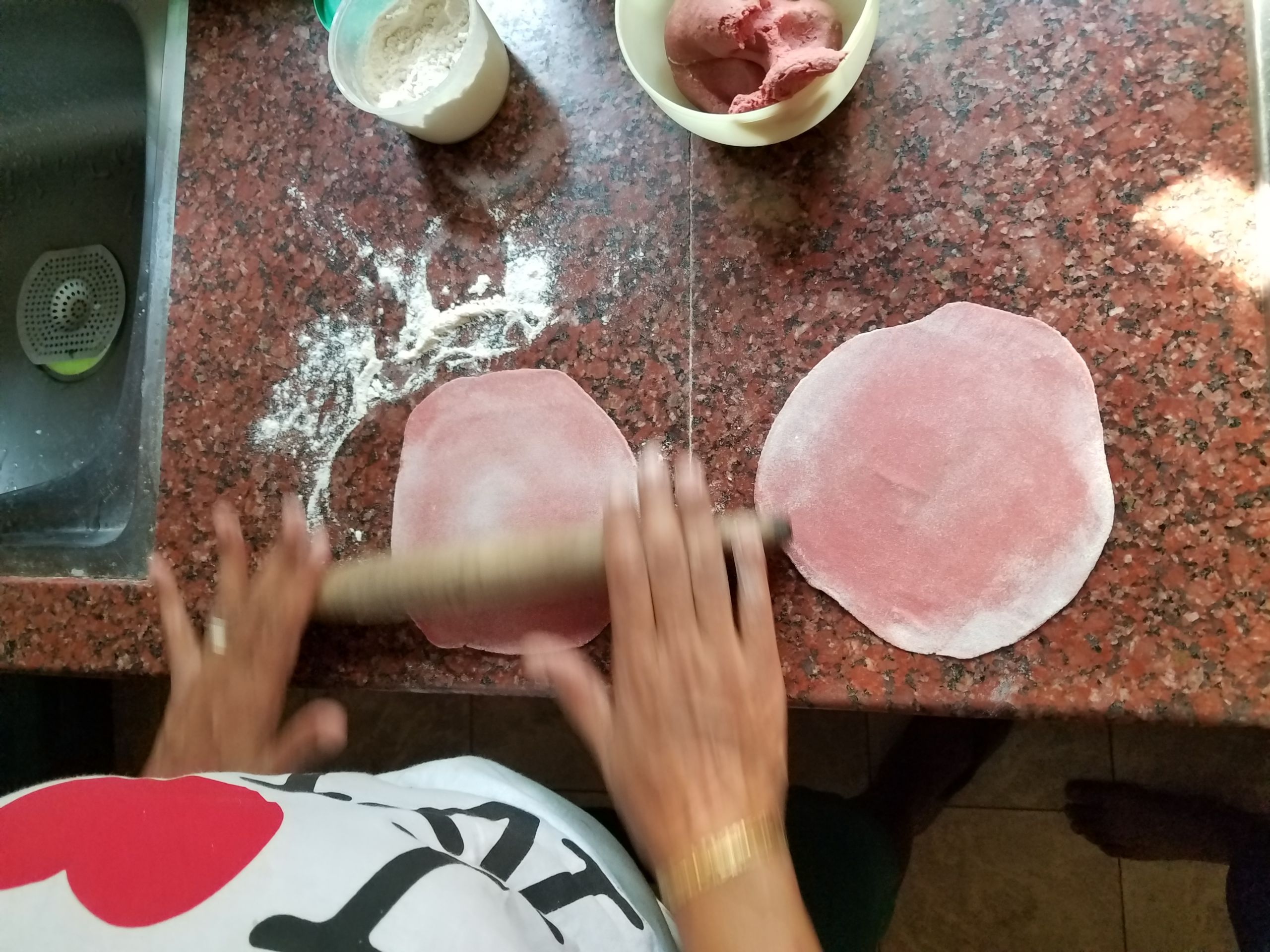 Flour, salt, yeast and water. I put the ingredients into the glass Pyrex bowl I usually use to start pizza dough in. I’ve made this recipes more times than I can remember. Last year and the year before that, it was an almost every Thursday night/Friday morning ritual for us. Sometimes he would heat the oven and assemble the pizzas in the cast iron pans before I got home from work and other times it was my task. With artichoke hearts. Check. Sausage. Check. Mozzarella. Not optional and hence, check and check. Some days the sauce was homemade but there was also enough room in our hearts for jars straight off the grocery shelves.
Flour, salt, yeast and water. I put the ingredients into the glass Pyrex bowl I usually use to start pizza dough in. I’ve made this recipes more times than I can remember. Last year and the year before that, it was an almost every Thursday night/Friday morning ritual for us. Sometimes he would heat the oven and assemble the pizzas in the cast iron pans before I got home from work and other times it was my task. With artichoke hearts. Check. Sausage. Check. Mozzarella. Not optional and hence, check and check. Some days the sauce was homemade but there was also enough room in our hearts for jars straight off the grocery shelves.
Before I made the recipe for the dough “blog official” (“” because bread-making can’t be set in stone. Run! It’s a fake!), each week I would try a new iteration of the recipe I perfected only in my head. It wasn’t on purpose. For one, I never wrote it down. I would change the proportions of flour, add a little more yeast, use a completely different yeast, wear an apron, don’t wear an apron – all of these minute differences would yield a completely new pizza experience each week. There were some Fridays where I was so excited about the outcome and others where I struggled to remember what step I changed the previous week. I just wanted to eat. Each time though, there was a little more to love.
Earlier this year, I illustrated a recipe that I thought was the best of all my time experimenting. Scribbling on paper gave it an air of finality that I wasn’t quite expecting to get worried about. This was a dough that grew with me, a non-bread maker in a bread hobbyist world. I made pizza because I was hungry. I dropped flour all over my shirt before I had to work because it made me happy. I wasn’t afraid that the recipe wouldn’t work. What made me nervous was if this known joy could be translated through just words. The way the dough sticks to every digit the first time you sink your hands into the bowl and bring it all together. Kneading and knowing when the heel of your hand could dig into the pillowy dough, closest to your body, one more time. There are more small stories I wouldn’t ever be able to write into the recipe. Sometimes, that is what you lose when you parcel away recipes for the Internet.
One of these stories came to me when I was kneading dough last week. It’s something I hadn’t thought about in a long time, probably ever. I learnt to make dough from watching my parents, Roma, my grandma. Nobody explicitly taught us to cook. Well, I was never interested in it to begin with. As a child, I heard people at parties say to my parents, “Oh you have three girls! They must help you so much at home.” My dad would always reply something along the lines of we don’t do shit (minus the expletive). It was internalized in my young mind that “daughter” = house help, so when the time came where I could have learned how to cook, I told myself I didn’t like it. But all that time, I was watching the people around me do so. My dad did most of the cooking and shopping too. He was just quicker and impatient, but he also got creative joy out of it.
I remembered a summer afternoon where we asked to go fishing at the river near my uncle’s house. More than fishing, we would run through the cultivated paddies, trying to find what our little minds thought were the best spots. Traffic was sparse. People who weren’t from nearby villages barely knew this place existed beyond the main roads that passed by it. It was not far from where we lived but we were spoilt enough to get a parent to take us there faster.
My father went into the kitchen to make the dough we would use as bait to catch the small local river fish. (Gluten! For fishing! Sorry Indian Jesu.) He had to go back to work after he dropped us off so he didn’t waste much time after his afternoon nap. He quickly threw together the flour and water into a steel bowl, kneading it into a small ball until it was smooth, in case the fish were too picky about lumpiness. There wasn’t much fussing but I internalised (and now, romaticise) that rolling shoulder, the push and tumble over of the dough by the right hand, while the left held on the bowl. Every motion that brought us closer to what I know as chapati. In this case, fast food for fish.
When I interview myself as a world-famous chef, I ask the question: Who taught you to cook? Only recently has the answer been “Nobody”. Nobody taught us like “Hey! We’re going to learn this today!” And yet, we seemed to have grasped it all through observation. Sometimes I regret giving too much attention to old school social banter about what girl children were good for at home. Maybe I would have forced my way into many more cooking adventures much earlier. But as it goes with kids, we noticed everything. I don’t think it’s by fluke that I have a chef for a younger sibling and an egg doctor for an elder one. It’s also no coincidence that I write about food and let it consume my every thought (including conduction imaginary interviews).
We had some of the most passionate culinary role models, who put some love and a lot of sweat into every meal they conceived. Chapati was one of the first – if not *the* first – foods I was invited into the kitchen to help with and it became the first foods I made after moving to America. I still cannot make a perfectly round chapati but it doesn’t matter because my grandma made them square, my mother puffed and browned them over a stove burner and my father always made sugared ones for Gayle an extra one for the dog.
It all began with flour, salt and water. I just added the yeast.
